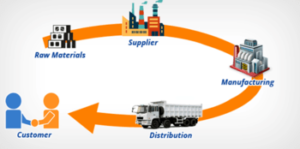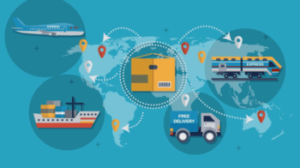In March 2019, the Wuhan province of China experienced an outbreak that later led to the shutdown of supply chains on a global scale. This outbreak was followed by a lockdown in all of China and, within a few months, the world. Thanks to these lockdowns, many problems were about to arise which would lead to complications for several industries essential for the world.
The pandemic gave rise to the identification of numerous vulnerabilities within localized and international supply chains, such as dependency on a limited number of suppliers for the import of materials needed in manufacturing, and the lack of efficiency within small-scale logistics companies.
However, the resilience of private and public entities alike has helped the human race overcome the adverse conditions that were exposed and accelerated by Covid-19. This exposure later allowed industries to maximize their efficiency by the integration of innovation within human resources and technological innovations as well.
By March 2020, production and shipping levels had recovered to 92% of pre-pandemic production levels, exactly a year after the original outbreak. And today, we’re going to talk about the extensive effects of Covid-19 on the pandemic, and how logistics has evolved over the past year to overcome unexpected adversities.
How Covid-19 Affected Global Supply Chains
Following the outbreak in Wuhan, China, many countries began expressing concern over Covid-19. Shortly after, nearly all major countries had found cases of Covid-19 within their borders, deeming it too late to prevent an outbreak. This meant that governments were left to do damage control. And to curb outbreaks within a country, each government began introducing strict guidelines for businesses and public gatherings.
One of the most affected sectors was the logistics sector, which had to deal with problems such as a lack of human labor thanks to lockdowns, and delays caused by adherence to social distancing policies which hindered efficiency.
The shutdown of international borders in many parts of the world was another factor that played a major role in the formation of bottlenecks within road-based freight shipping. Because of this, the trucking sector suffered on multiple ends. Aside from the bottlenecks, increased testing and isolation meant that truckers returning to their countries were forced to go into isolation for 14 days following their return from a delivery which meant that many shipping companies became short on truck drivers, which compounded the already present shortage of truckers in various countries.
Covid-19 Induced Recession Causes Demand Shock
Due to the pandemic and decreased economic activity on such a global scale, almost every continent began suffering adverse economic conditions such as a drop in employment, heightened inflation rates, and many other factors which resulted in a slow forming global recession whose effects we are still experiencing today. Many experts speculate that the future holds a dark outlook for global economic activity, which could mean that the supply chain industry will suffer yet another loss thanks to rapid decreases in product demand worldwide.
However, this recession isn’t affecting all industries in the same way. While industries like automobiles, consumer goods, travel and many others have faced decreased demand due to lockdown restrictions at every level. Logistics has been booming in the E-commerce industry. Online shopping and food delivery have experienced exponential growth, with a majority of workforce adapting to the Work-From-Home (WFH) model. Essentially, all goods related to enhancing customer experience within the home have been in higher demand than the last 5 years combined.
DocShipper Advice
DocShipper tip: If you have any questions regarding the packaging of your goods, don’t hesitate to contact our experts! They will answer all your questions within 48 hours.
How the Supply Chain Industry Adapted to Covid-19

These guidelines or SOPs were mainly focused on two prongs. The first was social distancing both indoors and outdoors to prevent human-to-human transmission. While the second prong was an attack against residual particles left behind by humans, accomplished by regularly disinfecting touchpoints that were frequented by workers.
The result of these SOPs was that valuable time was rightfully spent ensuring protection against the virus rather than maximizing output. However, the logistics industry is resilient. As can be seen, by the many innovations they integrated within record times to ensure that their operations remained at maximum output, which could be the only factor that allowed the industry to return to 92% of pre-pandemic levels within as little as one year.
Contribute with your content to inspire thousands of logistics readers through our blog. Publishing posts is a daily mission for us
The Innovations That Followed Covid-19
Due to Covid-19, many shortfalls became exposed after the implementation of lockdowns around the world. International supply chains began to crumble due to a lack of short-route delivery methods. And to address this problem, many innovative companies began experimenting with drone delivery, which is currently active in first-world countries on a small scale.
Another innovation to combat a lack of transport personnel was to use available space within passenger flights to facilitate the movement of important cargo such as medical supplies. Another alternative method that companies have adapted to help them transport goods during the pandemic is the use of railway transport systems. Railways have been experiencing higher demand around the world thanks to their ability to carry extremely high quantities of load compared to trucks and flights.
But within the Logistics industry, there have been many adaptations that focus on improving efficiency while ensuring that precautions are taken against infection. The first form of innovation that is being implemented on a massive scale is digitalization. It is being used to improve freight tracking and inventory forecasting to prevent delays and shortages.
Another rather noticeable step taken by giants in the industry is known as near shoring. Near shoring is the practice of moving vital components of the supply chain closer to the home country of the company, thus minimizing the potential distance that a good needs to travel. Especially for regions like Europe, which has been dependent on China for its raw materials, near shoring provides the chance to lessen dependency on external supply chains.
DocShipper info
DocShipper Tip: If you have any questions about the transportation of your goods, please do not hesitate to contact our DocShipper experts !
They will support you during the whole logistic process, and guide you to the best solution for your project!
Outlook For The Future
Many experts speculate that the logistics industry will be undergoing changes that could both benefit and harm the efficiency of logistics worldwide. Implementation of technological innovations like IoT, warehouse automation, data analytics, and robotics could be one of the driving factors that decide how well the industry does in the future.
But while internal efficiency is being improved, factors such as tightened border restrictions because of the pandemic will make it harder to keep financial costs down. Another result may be the prevalence of bottlenecks at border checkpoints thanks to social distancing protocols.
Another speculation is that the simplification of supply chains will be brought about by measures such as near shoring, which will result in shorter supply routes leading to shortened times for the “supplier-to-consumer” delivery process. In conclusion, efficiency and ease of access will be improved for supply chains. But it may also be subject to changes in practices brought about by new waves of Covid-19.
FAQ | From First Mile To Last Mile: How Logistics Changed Over The Last Year!
Thanks to protocols put in place to prevent the spread of Covid-19, many cross-border restrictions have been amped up. Because of this, shipping by Air, Road, & Sea has become backed up thanks to an excessive workload. However, the railway sector is capable of carrying heavy loads and is one of the most under-used methods of shipping.
Covid-19 is one of the main reasons for such strict policies between borders. And the only way to open up border restrictions is to be rid of the virus. However, you can ensure that your shipments take as little time as possible by verifying your employee vaccinations and ensuring that your paperwork is in order.
The prices of shipping services vary daily, which is why it’s difficult to provide an exact quote. But you can get an accurate quote by providing a shipping company with important details such as the weight and dimensions of a shipment, the originating and receiving country, and the deadline. Your total amount would increase along with the weight, distance, and urgency of delivery.
Finding a reliable shipping company is difficult because of the high level of competition within the industry. The safest method would be to get in touch with a few shipping companies and discuss their terms on a “sample” shipment. You can choose the specifications and judge their quotations and projected deadlines. And to verify their efficiency, you can check reviews online, but be careful to look out for fake reviews.
There are a few ways you can do this. The conventional method is to call your shipping company and inquire through them or by calling the recipient who will be present at the last mile of the shipping process. However, many good shipping companies have provided digital tracking through their web portals as well, which could be the easiest way to track shipments in real-time.

About the Author
I have been associated with Animation Iconix and Tech Industry for a decade now. I, Nathan Enoch Burridge, have held numerous key positions in various reputable companies, currently with London storage company.
Read More
Looking for more? These articles might interest you:
- Coronavirus (Covid-19) impacts on import/export business
- How does Coronavirus impact international supply chain?
- 💡How to find a good product to sell?
- How to find your reliable supplier for your business? [Fair Trade Guide]
- AliExpress | Use the Chinese panacea to sell your products online
- How a sourcing strategy can rocket your margin?
Need Help with Logistics or Sourcing ?
First, we secure the right products from the right suppliers at the right price by managing the sourcing process from start to finish. Then, we simplify your shipping experience - from pickup to final delivery - ensuring any product, anywhere, is delivered at highly competitive prices.


Fill the Form
Prefer email? Send us your inquiry, and we’ll get back to you as soon as possible.
Contact us






